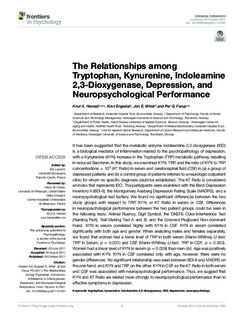| dc.description.abstract | It has been suggested that the metabolic enzyme indoleamine 2,3-dioxygenase (IDO) is a biological mediator of inflammation related to the psychopathology of depression, with a Kynurenine (KYN) increase in the Tryptophan (TRP) metabolic pathway, resulting in reduced Serotonin. In this study, we examined KYN, TRP, and the ratio of KYN to TRP concentrations × 103 (KT Ratio) in serum and cerebrospinal fluid (CSF) in (a) a group of depressed patients and (b) a control group of patients referred to a neurologic outpatient clinic for whom no specific diagnosis could be established. The KT Ratio is considered an index that represents IDO. The participants were examined with the Beck Depression Inventory II (BDI-II), the Montgomery Aasberg Depression Rating Scale (MADRS), and a neuropsychological test battery. We found no significant differences between the two study groups with respect to TRP, KYN, or KT Ratio in serum or CSF. Differences in neuropsychological performance between the two patient groups could be seen in the following tests: Animal Fluency, Digit Symbol, the DKEFS Color-Interference Test (Naming Part), Trail Making Test A and B, and the Grooved Pegboard Non-dominant Hand. KYN in serum correlated highly with KYN in CSF. KYN in serum correlated significantly with both age and gender. When analyzing males and females separately, we found that women had a lower level of TRP in both serum (Mann-Whitney U-test: TRP in Serum; p = 0.001) and CSF (Mann-Whitney U-test: TRP in CSF; p = 0.003). Women had a lower level of KYN in serum (p = 0.029) than men did. Age was positively associated with KYN. KYN in CSF correlated only with age, however; there were no gender differences. No significant relationship was seen between BDI-II and MADRS on the one hand, and KYN and TRP on the other. KYN in CSF as the KT Ratio in both serum and CSF was associated with neuropsychological performance. Thus, we suggest that KYN and KT Ratio are related more strongly to neuropsychological performance than to affective symptoms in depression. | |
